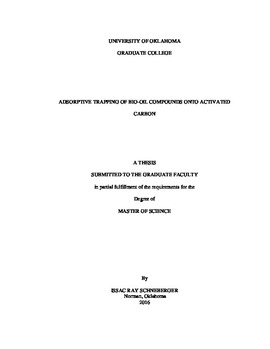| dc.contributor.advisor | Lobban, Lance | |
| dc.contributor.author | Schneberger, Issac | |
| dc.date.accessioned | 2016-07-29T16:30:11Z | |
| dc.date.available | 2016-07-29T16:30:11Z | |
| dc.date.issued | 2016-08 | |
| dc.identifier.uri | https://hdl.handle.net/11244/44595 | |
| dc.description.abstract | Industrialization and its long-term effects on the environment are receiving increased scrutiny from both political and environmental pundits questioning environmental sustainability in a time of globalization. Traditional fossil fuels have been the center of criticism for rising carbon emission levels in the Earth’s biosphere. A cleaner, renewable, and carbon neutral fuel will be necessary to compete with fossil fuels on the global market if industrialized societies continue to implement policies curtailing emissions. Lignocellulosic biofuels can help fill this role for the planet’s energy demands, specifically, thermochemical conversion of lignocellulosic biomass to produce usable hydrocarbon fuels and chemicals. Fast pyrolysis and torrefaction are two methods being developed to produce bio-oil from lignocellulosic biomass. The complexity of the bio-oil mixtures produced from these methods presents technical challenges in the catalytic upgrading of the bio-oil into biofuels and processing of the bio-oil in current industrial equipment. If cost efficient catalysts and process equipment are to be used in the upgrading processes, separation strategies will need to be implemented to simplify and stabilize the bio-oil mixture.
Strategies were studied for the separation of bio-oil vapors from pyrolysis and torrefaction processes through trapping and thermal techniques. Activated carbon acted as the experimental trapping component. Model compounds were used to represent specific compound groups of bio-oil vapors. The effectiveness of these separation strategies was studied using an SRI gas chromatograph through the use of retention times and dynamic temperature profiles employed on the adsorbent trap. Adsorption behavior of the model bio-oil vapor compound groups over activated carbon traps was also studied with the SRI gas chromatograph and explained as the process in which the adsorbent reaches saturation and excess analyte that does not adsorb travels through the column. The adsorbents were then tested in the use of a pyroprobe to examine separation effectiveness for real bio-oil vapor mixtures. Lastly, the adsorbents of interest were characterized for heats of adsorptions, surface area, pore size, pore volume, and analyte capacity.
Methoxyphenolic compounds in bio-oil vapors adsorb the most strongly to the activated carbon active sites compared to other components found in bio-oil vapors. This strongly bonding principle for methoxyphenolic compounds has been demonstrated by the study of residence time of methoxyphenolic compounds over activated carbon and activated carbon traps implemented in pyrolysis systems. The methoxyphenolic compounds adsorbing stronger than other bio-oil componen is the most desirable outcome for separation of the bio-oil component families as the methoxyphenolic compounds present significant hazards to downstream catalytic upgrading.
It has been observed that levoglucosan in pyrolysis vapors can be thermally trapped onto activated carbon in pyrolysis units.
The capacity and surface characteristics of new and used adsorbents have been analyzed with thermogravimetric analysis and physical adsorption characterization. The capacity analysis has shown methoxyphenolic compounds have the highest capacity of model compounds test at all temperatures. It has been shown that activated carbon loses surface area after use as an adsorbent of model bio-oil compound vapors. This loss in surface area, however, apparently leads to negligible loss in capacity of the components desired for trapping. | en_US |
| dc.language | en_US | en_US |
| dc.subject | Activated Carbon, Bio-oil, Bio-Fuel | en_US |
| dc.title | Adsorptive Trapping of Bio-oil Compounds onto Activated Carbon | en_US |
| dc.contributor.committeeMember | Crossley, Steven | |
| dc.contributor.committeeMember | Mallinson, Richard | |
| dc.date.manuscript | 2016-06-20 | |
| dc.thesis.degree | Master of Science | en_US |
| ou.group | College of Engineering::School of Chemical, Biological and Materials Engineering | en_US |
